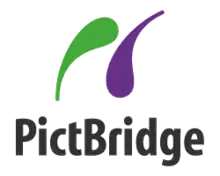
PictBridge is a historical computing industry standard introduced in 2003 from the Camera & Imaging Products Association (CIPA) for direct printing. It allows images to be printed directly from digital cameras to a printer, without having to connect the camera to a computer. Its formal name is "Standard of Camera & Imaging Products Association CIPA DC-001 — 2003 Digital Solutions for Imaging Devices".[1] CIPA DC-001-2003 Rev. 2.0 has been published in 2007.
Implementation
PictBridge is typically implemented using USB ports and the USB protocol. PictBridge-capable printers typically have a USB type A port which is connected by cable to the USB port of a PictBridge-capable digital camera (typically a Mini-B). The user selects the images on the camera to print.
Licensing
The PictBridge specification is not an open standard; it can only be obtained from CIPA after agreement not to disclose any information from the specification to others.[2] In practice, this means that PictBridge cannot be implemented as free and open source software, other than by reverse-engineering the protocol, if publishing source code of an implementation of the PictBridge standard is considered to count as "disclosing information" from the specification.
A printer may implement functions similar to a PictBridge printer without the non-disclosure agreement merely by treating the camera's memory as a USB mass storage device, although the user interface for image selection would necessarily be on the printer rather than the camera in this case.
See also
References
- ↑ "Archived copy" (PDF). Archived from the original (PDF) on 2004-07-27. Retrieved 2004-07-27.
{{cite web}}: CS1 maint: archived copy as title (link) - ↑ section 2.2 of the agreement
External links
- CIPA PictBridge Standard Website
- Explanation on Canon's website at the Wayback Machine (archived September 27, 2009)
- CIPA comprehensive list of PictBridge capable printers and cameras